HP Stream 7 Review: A $119 Windows Tablet
by Brandon Chester on December 19, 2014 8:00 AM ESTCPU Performance
Inside the Stream 7 we have Intel's Atom Z3735G, which is a quad core Bay Trail part that has a base frequency of 1.33GHz and a burst frequency of 1.83GHz. It's paired with 1GB of DDR3L-RS-1333 memory, where the RS stands for "Reduced Standby". As the name implies, it has a focus on improving standby battery life on devices like tablets. Z3735G unfortunately has one of the slower memory interfaces of the Bay Trail lineup, with only single channel support and a max memory bandwidth of 5.3Gbps. Nonetheless, the CPU itself is fairly powerful, especially for a $119 device.
Although the Stream 7 does run a full copy of Windows, I've decided to run it through our mobile workflows rather than our desktop/laptop ones because I believe most users are going to use it similarly to how they use other tablets. I will elaborate on this point later in the software section, but the main point is that the normal Windows desktop experience is just not very good on touchscreens, especially 7" 1280x800 displays. Because of this, it's better to run it through benchmarks where it can be compared to other tablets. The fact that PCMark requires more space than the Stream 7 physically has is also an issue.
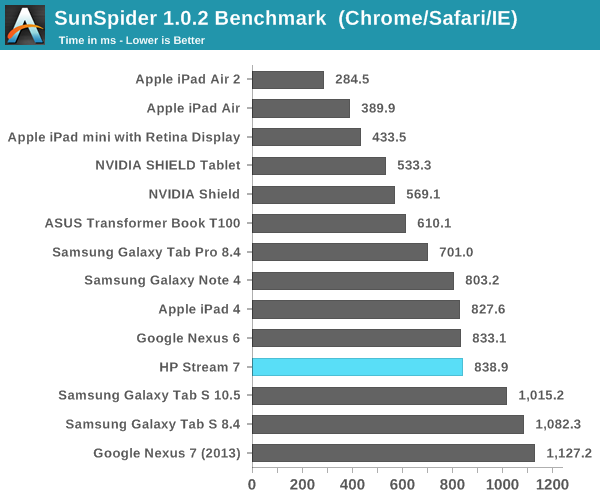

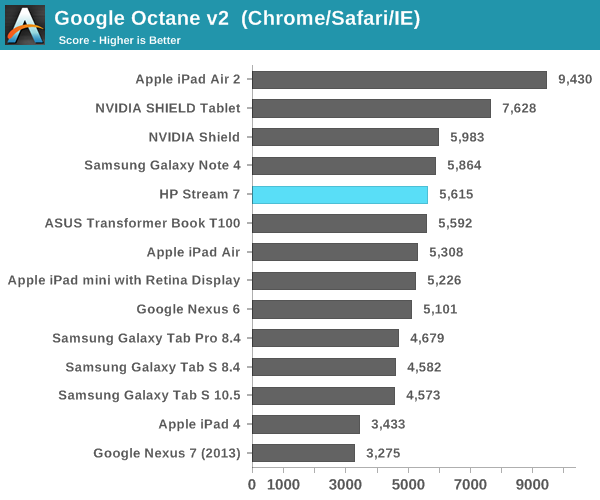
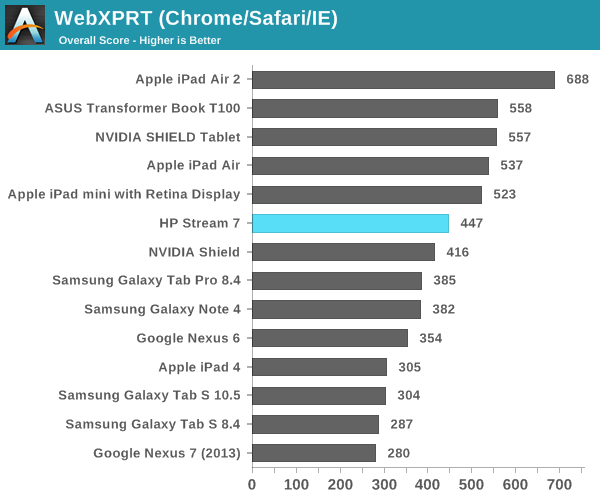
As you can see, Intel's latest Atom platform performs very well in our tests. It should be noted that these tests were performed using Chrome rather than IE, to maintain consistency with the results from previous Windows tablet reviews. This means that the Sunspider score leaves much to be desired, as Google has stopped focusing on it as an optimization target. Looking at our other tests, we see that the Stream 7 is not the fastest tablet, but it is still very fast. In fact, it's competitive with the silicon inside tablets that cost two or even three times as much, which is impressive.
GPU Performance
The Intel HD Graphics chip in Bay Trail is architecturally similar to Intel's HD 4000 graphics on Ivy Bridge. It's simply a cut down implementation with 4 EUs instead of the 16 in an Ivy Bridge chip. The implementation in Atom Z3735G scales from 311MHz to 646MHz as needed. Thankfully, the Windows Store has up-to-date versions of 3DMark and GFXBench available, so we can compare the Stream 7 to the other devices that we've benchmarked in the past.
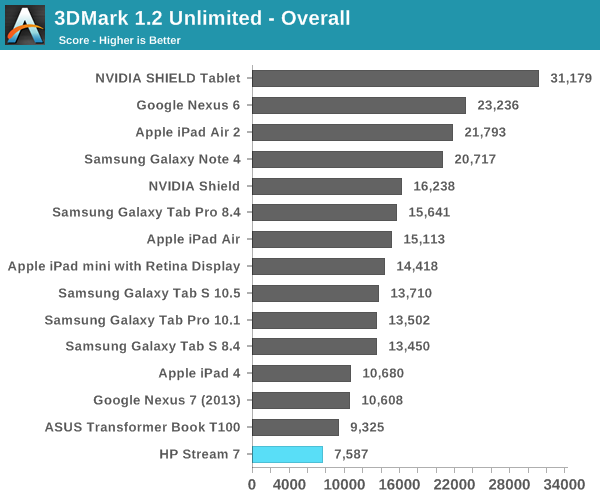
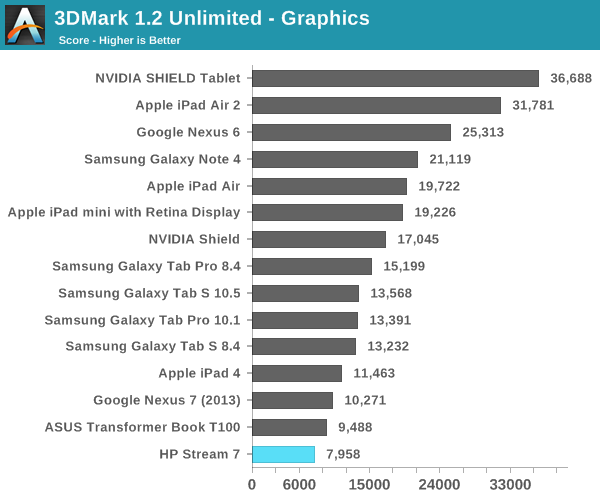
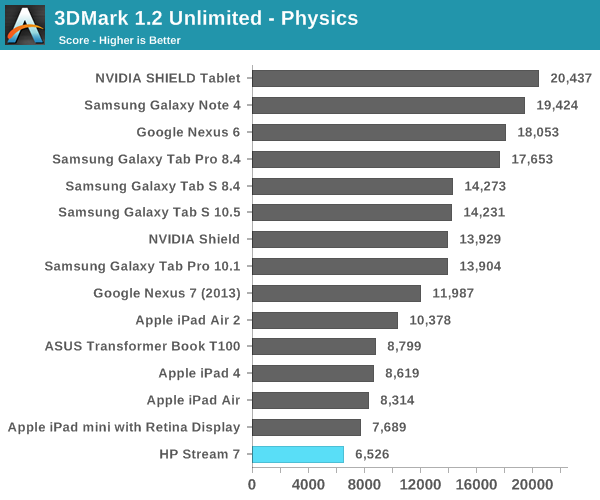
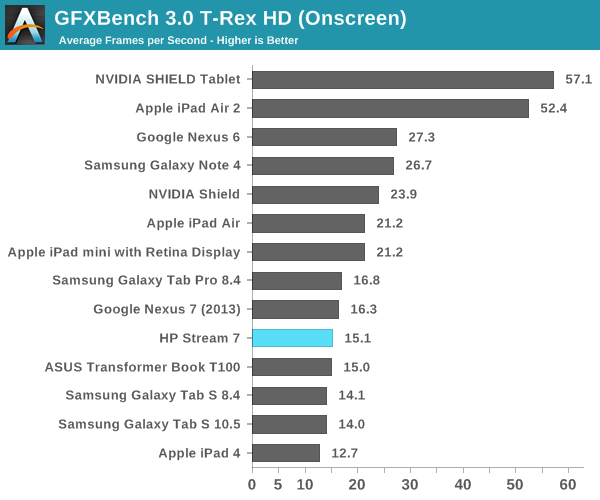
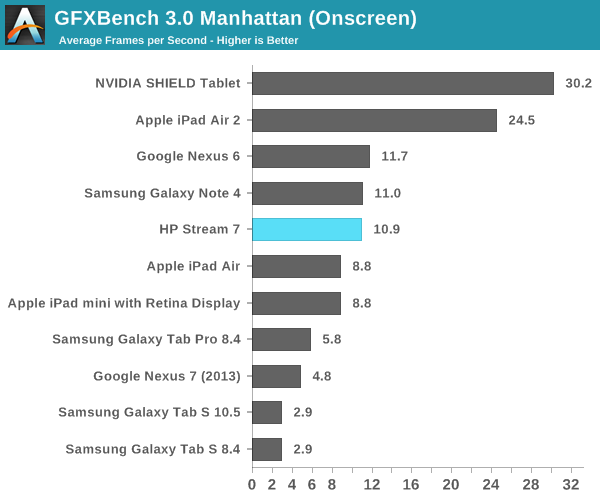


As you can see, Bay Trail isn't exactly a graphics powerhouse. However, the Stream 7's resolution means that the onscreen results aren't that bad, so you'll be able to get away with running some of the lighter games that you can on other platforms, provided of course that they're available on the Windows Store.










157 Comments
View All Comments
victorson - Friday, December 19, 2014 - link
Hey guys, you are doing a great job, but I can't help but wonder why do you insist on reviewing those absolutely boring devices?! There's a ton of amazing smartphones out there (lots of great ones from China, for instance) that you have not examined, yet we get to read about the HP Stream 7 that no one in their right mind cares about.icrf - Friday, December 19, 2014 - link
I'm curious about Windows tablets. Not enough to buy a $500 version, but maybe enough to buy a $100 version. I'm more likely to do that than buy the latest Chinese flagship that's difficult to get stateside. I appreciate the review.tipoo - Friday, December 19, 2014 - link
Exactly - and the EFI is accessible on this just like a normal PC, so you can install Linux on it too. A 100 dollar experiment isn't bad either, if you want to toy around with Linux on a tablet.mczak - Friday, December 19, 2014 - link
Just a warning if you want to install linux on it. I'm near certain this device just like similar ones has 32bit UEFI (as it runs a 32bit version of windows), and no traditional bios emulation (csm). 32bit linux distributions do not support UEFI, and 64bit ones generally require 64bit UEFI. Not saying this can't work (it is indeed possible to get this to work), but unless some distros decide to support 32bit UEFI this is quite problematic.wtallis - Saturday, December 20, 2014 - link
Honestly, if you know enough about Linux to have a chance of getting something useful running on such a resource-constrained tablet, EFI's not going to slow you down, especially since kernel 3.15 and later support loading a 64-bit kernel from 32-bit EFI.miles_russell - Thursday, February 12, 2015 - link
HP Stream 7 is not very popular to consumer and if you look on a consumer base review (such as http://www.tabletstop7.tk/ my favorite...) its nowhere to be found.DracheMitch - Friday, March 27, 2015 - link
I don't really think that New Zealand is a target market for HP...DracheMitch - Friday, March 27, 2015 - link
That's funny that for Linux, this is considered "resource constrained", and that Linux would have such a hard time being able to boot on it, but for Windows, this is a pretty workable device.Why is Linux so bloated? What does it have the hardware support of a 1990 Macintosh?
ENEMY OUTLAW - Thursday, January 12, 2017 - link
Where can I buy onemetayoshi - Friday, December 19, 2014 - link
As a previous owner of an Acer Iconia W4, I'm actually more inclined to buy a Windows tablet in the $500+ range than any of these lower end devices now. I mean, I definitely enjoyed my time I had with the tablet, and I pretty much agree with the pros and cons of having Windows on a tablet. But knowing those pros and cons as a starting expectation, I just feel like Windows on a tablet can be so much more and not as limited once you start getting the 64-bit Windows with 4 GB of RAM or more and 128 GB NAND or more (a more "standard" Windows configuration) such as the currently available $700 Dell Venue 11 Pro (Core M version). With lower end Windows tablets, unfortunately, the common app standard is not there, and for what I wanted to do with a Windows tablet, my W4 was just not up to par. With more powerful tablets, I feel you can take advantage of having Windows on a tablet, which is, ironically, being able to use the billions of standard Desktop Windows applications. In fact, I'm very excited about Core M tablets, and I'm probably going to put down some money on a Core M device once more OEMs start updating their Windows tablets with it.With that said, I'm excited to see a Bay Trail tablet review finally on Anandtech. I hope that means with Core M on the way, more Windows tablet reviews will be done on all points of the spectrum, from the cheap Atom processors, to the low powered but mid-priced Core M tablets that hopefully come out (like the Dell Venue 11 Pro), to the high end Surface Pros.